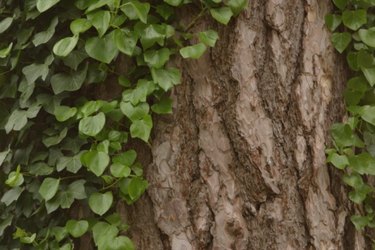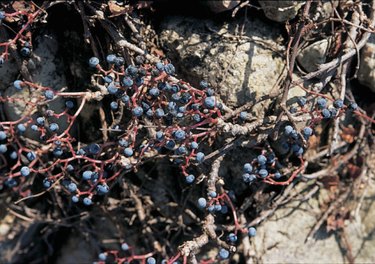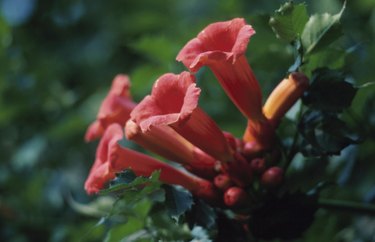
The many species of wild climbing vines add visual interest to the landscape with their twisting stems and lush foliage. They benefit wildlife with their dense growth of leaves that provide shelter, and their flowers that provide pollen and nectar for birds and butterflies. Mammals and birds also feed from the fruit some vines produce. Wild vines can be detrimental to trees and shrubs, though, when they grow up them to great heights and create so much shade that the host plants can't survive.
Common Greenbriar
Video of the Day
You'll find common greenbriar (Smilax rotundifolia) growing along the edges of northern woodlands and in open fields, where it tolerates a variey of growing conditions, though it prefers clay and alkaline soil and thrives in partial shade and full sun. Its woody stems sprout tendrils that allow it to cling to trees and fences. It is densely covered with black thorns, and bears drooping clusters of small, dark-blue berries in late autumn that the birds enjoy. The heart-shaped green leaves turn golden-yellow in the fall and may remain on the vine into December. The young tendrils can be cooked and eaten like asparagus and the leaves and young shoots are also edible. The roots can be crushed into a powder and used as a thickening agent in cooking.
Video of the Day
Wild Grapes

Wild grapes (Vitaceae) are perennial climbing or trailing vines comprising up to 60 species. Depending on the species, the vine can prefer rich, moist soil or sandy, dry soil. They thrive in the full sun. Wild grapes are native to the edges of woodlands in central and eastern North America. Their woody stems are covered with large leaves which have prominent parallel veins. In spring the plant produces long, drooping clusters of light green flowers. In autumn, the vines produce tiny bunches of purple grapes that are edible but not as sweet as commercially grown grapes. Birds eat the fruit and scatter the seeds.
Trumpet Creeper

Trumpet creeper (Bignoniaceae) is a prolific vine that can reach 40 feet high. It's native to the southeastern states of the U.S. and has become naturalized in the Great Lakes region. In July, the vine becomes heavy with orange-red trumpet-shaped flowers that attract butterflies and hummingbirds. Trumpet creeper, or trumpet vine, grows well in average soil and prefers full sun. It is a good choice if you need a fast-growing cover for unattractive tree stumps or rocky areas. It can be invasive so allow plenty of room if you introduce it to your garden.
Dutchman's Pipe
Aristolochia tomentosa is commonly called Dutchman's pipe because of its long, curved, flared flowers that resemble Dutch tobacco pipes. These unusual flowers bloom from May to June but are often obscured by the vine's dense growth of large green leaves. This plant grows well in average soil and tolerates full sun to partial shade. This vine is a perennial that climbs to 30 feet high. Its native range include southeastern and south central states in the U.S., though plantings have extended its range as far north as New England. The carrion fragrance of the flowers attracts the pipevine swallowtail butterfly.